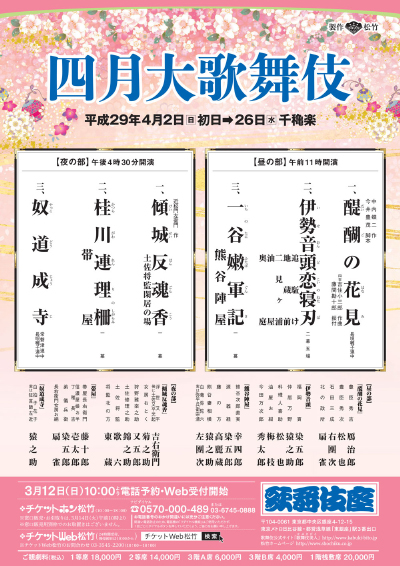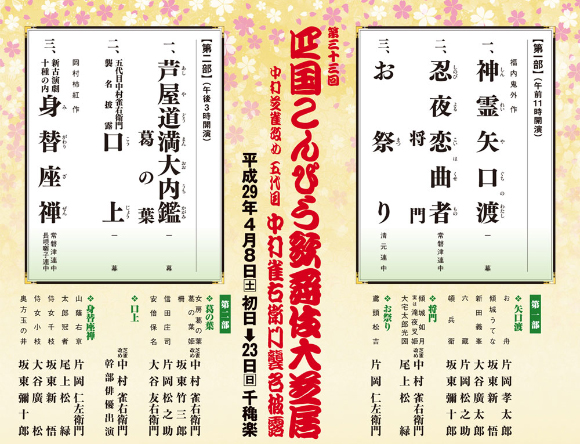| APRIL 2017 |
|
4 shows in T˘ky˘ (Kabukiza, Akasaka Act Theater, Makuhari Messe), 2 on Shikoku island (Kanamaruza), 1 in Shimonoseki (Shimonoseki Shimin Kaikan) and 1 tour (Classics Tour)!
|
| Kabukiza (T˘ky˘) |  |
| Dates | 2 ~ 26 April 2017 (Shigatsu ďkabuki) April Grand Kabuki |
| MatinÚe |
Daigo no Hanami
|
| Evening |
Keisei Hangonk˘ (Domo Mata) |
| Casting |
Living National Treasure Sakata T˘jűr˘, Living National Treasure Nakamura Kichiemon, Living National Treasure Nakamura T˘z˘, Matsumoto K˘shir˘, Onoe Kikunosuke, Nakamura Ganjir˘, Nakamura Senjaku, Ichikawa Sadanji, Ichikawa Ennosuke, Ichikawa Somegor˘, Nakamura Kinnosuke, Kataoka Hidetar˘, Nakamura Karoku, Nakamura Matagor˘, Ichikawa Komaz˘, Nakamura Kazutar˘, Nakamura Baishi, Onoe Matsuya, Ichikawa Udanji, Ichimura Manjir˘, Ichikawa Monnosuke, Ichikawa Emisabur˘, Ichikawa Emiya, Kamimura Kichiya, Matsumoto Kingo, Nakamura Kash˘, Sawamura S˘nosuke, Sawamura Yoshijir˘, ďtani Keiz˘, Nakamura Matsue, Arashi Kitsusabur˘, Nakamura Jűjir˘, Ichimura Kitsutar˘, Nakamura Kichinoj˘, Ichikawa K˘tar˘, Nakamura Tanenosuke, Nakamura Mantar˘, Nakamura Yonekichi, Nakamura Hayato, Ichimura Takematsu, Ichikawa Otora, Ichikawa Ukon, ďtani Ryűsei |
| Comments |
The highlights of the two programs for the April Grand Kabuki at the Kabukiza are:
Moreover, ďtani Ryűsei, the son of ďtani Keiz˘, makes his hatsubutai. He performs in the dance "Yakko D˘j˘ji". He will perform in the dance "Yakko D˘j˘ji". Here are below the details of the April Grand Kabuki Programs at the Kabukiza:
|
 |
| Kanamaruza (Konpira) |
| Dates | 8 ~ 23 April 2017 (Shikoku Konpira Kabuki ďshibai) |
| MatinÚe |
Shinrei Yaguchi no Watashi (Tonbŕ Sumika) |
| Evening | |
| Casting |
Living National Treasure Kataoka Nizaemon, Nakamura Jakuemon, Band˘ Yajűr˘, Kataoka Takatar˘, Band˘ Takesabur˘, Onoe Sh˘roku, ďtani Tomoemon, Band˘ Shingo, ďtani Hirotar˘, ďtani Hiromatsu, Kataoka Matsunosuke |
| Comments |
33rd edition of the Spring Kabuki performance Shikoku Konpira Kabuki ďshibai at the Kanamaruza on Shikoku Island! Nakamura Jakuemon V celebrates his shűmei at the Kanamaruza!
|
 |
| Akasaka Act Theater (T˘ky˘) |  |
| Dates | 6 ~ 25 April 2017 (Akasaka ďkabuki) Akasaka Grand Kabuki |
| Program |
Yume Maboroshi-ka Koi Z˘shi (Akame no Tensei) |
| Casting |
Nakamura Kankur˘, Nakamura Shichinosuke, Kataoka Kamez˘, Ichikawa En'ya, Nakamura Kikaku, Nakamura Tsurumatsu, Nakamura Ich˘ |
| Comments |
5th edition of the Akasaka Grand Kabuki, which was started in September 2008 by Nakamura Kanzabur˘ XVIII, the head of the Nakamuraya guild.
|
 |
| Classics Tour | |
| Dates | 1 ~ 23 April 2017 (Koten he no Izanai) Invitation to the Classics |
| Program |
Otokodate Hana no Yoshiwara |
| Casting |
Ichikawa Ebiz˘, Kataoka Ichiz˘, Ichikawa Kudanji, Ichikawa Botan |
| Comments |
A special tour in 14 cities for the heir of the Naritaya guild. The dance-drama "Otokodate Hana no Yoshiwara" was created and premiered in 2014. |
| Shimonoseki Shimin Kaikan (Shimonoseki) | |
| Dates | 7 ~ 9 April 2017 (Band˘ Tamasabur˘ Tokubetsu Buy˘ K˘en) Band˘ Tamasabur˘ Special Dance Performances |
| Program |
Keisei |
| Casting |
Living National Treasure Band˘ Tamasabur˘ |
| Comments |
A special Buy˘ program starring the amazing Living National Treasure onnagata Band˘ Tamasabur˘ in Shimonoseki at the newly-renovated Shimonoseki Shimin Kaikan (Shimonoseki Civic Center).
|
| Makuhari Messe (Chiba) |
| Dates | 29 ~ 30 April 2017 (Ch˘kabuki) Ultra-Kabuki |
| Program |
Kuruwa Kotoba Awase Kagami |
| Casting | |
| Comments |
The world of Kabuki and the world of otaku collide for the second time in Kabuki history! Resulting from this spectacular collision, a new genre, the Ch˘kabuki (literally Ultra-Kabuki), was born in 2016 [more details]. Nakamura Shid˘ shares the stage with the virtual 3D creature Hatsune Miku. They perform "together" in a newly-created Ch˘kabuki drama. It is staged at the Makuhari Messe as part of the Niconico Ch˘kaigi 2017 event, an important yearly event for the otaku tribes. |
|
|
| Contact | Main | Top | Updates | Actors | Plays | Playwrights | Programs | Links | FAQ | Glossary | Chronology | Illustrations | Prints | Characters | Derivatives | Theaters | Coming soon | News |